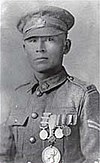Portal:Indigenous peoples of the Americas
Appearance
(Redirected from Portal:Indigenous peoples of the America)
Discover Wikipedia using portals
Portal maintenance status: (June 2018)
|
The Indigenous peoples of the Americas PortalCurrent distribution of Indigenous peoples of the Americas In the Americas, Indigenous peoples comprise the continent's pre-Columbian inhabitants prior to European settlement in the 15th century, as well as the ethnic groups that identify with the continent's pre-Columbian population as such. These populations exhibit significant diversity; some Indigenous peoples were historically hunter-gatherers, while others practiced agriculture and aquaculture. Various Indigenous societies developed complex social structures, including pre-contact monumental architecture, organized cities, city-states, chiefdoms, states, kingdoms, republics, confederacies, and empires. These societies possessed varying levels of knowledge in fields such as engineering, architecture, mathematics, astronomy, writing, physics, medicine, agriculture, irrigation, geology, mining, metallurgy, sculpture, and goldsmithing. Indigenous peoples continue to inhabit many regions of the Americas, with significant populations in countries such as Bolivia, Canada, Chile, Colombia, Ecuador, Guatemala, Mexico, Peru, and the United States. There are at least a thousand different Indigenous languages spoken across the Americas, with 574 federally recognized tribes in the US alone. Some languages, including Quechua, Arawak, Aymara, Guaraní, Mayan, and Nahuatl, have millions of speakers and are recognized as official by governments in Bolivia, Peru, Paraguay, and Greenland. Indigenous peoples, whether residing in rural or urban areas, often maintain aspects of their cultural practices, including religion, social organization, and subsistence practices. Over time, these cultures have evolved, preserving traditional customs while adapting to modern needs. Some Indigenous groups remain relatively isolated from Western culture, with a few still considered uncontacted peoples. (Full article...) Selected article An igloo (Inuit language: iglu, Inuktitut syllabics ᐃᒡᓗ [iɣˈlu] (plural: igluit ᐃᒡᓗᐃᑦ [iɣluˈit]) or snowhouse is a type of shelter built of snow, originally built by the Inuit. Although igloos are usually associated with all Inuit, they were predominantly constructed by people of Canada's Central Arctic and Greenland's Thule area. Other Inuit people tended to use snow to insulate their houses, which were constructed from whalebone and hides. Snow is used because the air pockets trapped in it make it an insulator. On the outside, temperatures may be as low as −45 °C (−49 °F), but on the inside the temperature may range from −7 °C (19 °F) to 16 °C (61 °F) when warmed by body heat alone. Selected imageGeneral imagesThe following are images from various Indigenous peoples of the Americas-related articles on Wikipedia.
Selected biography Francis Pegahmagabow MM** (March 9, 1891 – August 5, 1952) was the First Nations soldier most highly decorated for bravery in Canadian military history and the most effective sniper of World War I. Three times awarded the Military Medal and seriously wounded, he was an expert marksman and scout, credited with killing 378 Germans and capturing 300 more. Later in life, he served as chief and a councilor for the Wasauksing First Nation, and as an activist and leader in several First Nations organizations. He corresponded with and met other noted aboriginal figures including Fred Loft, Jules Sioui, Andrew Paull and John Tootoosis. Did you know…
SubcategoriesRelated portalsThings you can do
Selected panoramaTopics
Recognized content
Featured articlesFormer featured articlesGood articles
Former good articlesDid you know? articles
In the News articlesAssociated WikimediaThe following Wikimedia Foundation sister projects provide more on this subject:
American indigenous language WikipediasAvañe'ẽ (Warani) · Aymar aru (Aymara) · ᏣᎳᎩ (Cherokee) · Chahta (Choctaw) · ᐃᔨᔫ (Cree) · ᐃᓄᒃ (Inuktitut) · Iñupiak · Kalaallisut (Greenlandic Inuit) · Mvskoke (Muscogee) · Nahuatlahtolli · Diné bizaad (Navajo) · Qhichwa Simi · Tsêhesenêstsestôtse (Cheyenne) Indigenous languages in Wikimedia Incubators: Alabama · Blackfoot · Chinook Jargon · Choctaw · Creek · Lakota · Micmac · Mohawk · Nheengatu · Northwestern Ojibwa · O'odham · Shoshoni · Unami-Lenape · Wüne pakina (Mapudungun) · Yucatec Maya · Central Alaskan Yup'ik · Zuni | |||||||||||||||||||||||||||||||||||||



